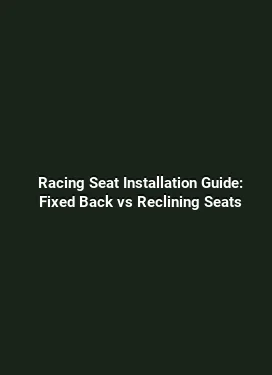Best Racing Seat Mounting Brackets for Low Seating Position: Interior & Safety Insights
Creating a cockpit that keeps the driver close to the vehicle’s center of gravity while maintaining comfort and safety is essential in high-performance driving. The mounting brackets that secure a racing seat play a pivotal role in achieving a low seating position, which in turn affects visibility, control precision, weight distribution, and occupant safety. This guide delves into the nuanced world of racing seat mounting brackets designed for a low profile, offering actionable details, installation considerations, material choices, and practical examples drawn from real-world applications.
When selecting mounting brackets, a thorough understanding of how bracket geometry, hole patterns, and adjustability interact with seat rails and the chassis is crucial. A low seating position can enhance aerodynamics and steering responsiveness, but it also demands precise alignment to preserve pedal reach, steering wheel alignment, and instrument visibility. The information presented here is meant to equip builders, racers, and enthusiasts with the knowledge to evaluate options, plan mounts, and implement installations that respect both safety standards and the realities of track use.
Understanding the Essentials of Low-Profile Mounting

Low-profile brackets reduce the distance between the seat cushion and the floor or mounting surface, often by utilizing compact crossbars, offset configurations, or angled adapter plates. The primary goal is to lower the driver’s hips without compromising legroom, hip support, or head clearance. In practice, this often means selecting brackets with shorter vertical profiles, strong mid-span support, and secure attachment points that preserve the seat’s integrity under lateral loads.
From a safety standpoint, every bracket set must maintain integrative strength with the seat rails, harness anchors, and seat side mounting points. The implementation should avoid interfering with seat adjustability or the operation of the seat belts and quick-release systems. In many racing environments, brackets are selected not only for their height but also for their ability to maintain consistent alignment during dynamic driving. Precision in the mounting location relative to the vehicle’s centerline helps balance the chassis’ yaw and pitch responses during aggressive cornering.
Key Design Considerations for Low-Profile Brackets

Mid-range to high-end brackets typically emphasize material quality, such as aerospace-grade aluminum or steel alloys with corrosion resistance. Critical design features include a robust inner rail connection, adequate weld seams or fastening hardware, and compatibility with a range of seat models. When evaluating products, look for: compatibility with a universal or specific seat model, the number and pattern of bolt holes, and the availability of offset options to fine-tune leg reach and pedal alignment.
Another important aspect is load distribution. Low-profile brackets must transfer seat and occupant forces to reinforced points on the vehicle’s floor or chassis without creating stress risers. To achieve this, many systems use reinforced gussets, triangulated supports, and multiple attachment points that distribute loads during high-G maneuvers. This translates into more predictable braking and turn-in behavior, particularly on tight, technical tracks where driver inputs demand instantaneous responses.
Materials and Finishes: Balancing Weight and Durability
The choice of material directly impacts weight, durability, and heat management inside the cockpit. Aluminum alloys are a common choice due to their favorable strength-to-weight ratio, but some setups favor steel for maximum rigidity and durability in harsh environments. Finishes such as powder coating or anodizing help resist corrosion from moisture, sweat, and road salts commonly encountered during endurance events. In addition, some brackets incorporate anti-fatigue design features or fatigue-tested connection points to extend service life in race conditions.
Practical testing shows that bracket stiffness contributes to seat stability under high lateral Gs. A stiffer mounting assembly reduces vibration, which can otherwise degrade steering feedback and pedal feel over long sessions. However, excessive stiffness can transfer road imperfections into the cockpit, potentially affecting driver comfort. The best solutions strike a balance by providing firm support while allowing a predictable, controllable amount of compliance in the seat mounting.
Installation Strategy: Aligning Low Seating with Pedal and Steering Geometry
Achieving a low seating position is not simply about dropping the seat lower; it requires holistic alignment of the entire driving triangle: steering wheel, pedals, and seat. Properly mounted brackets enable precise adjustment ranges that preserve comfort and control. Before drilling or permanently fastening brackets, perform a mock-up with the seat in place, verifying clearances to the steering wheel, dash components, and the door sill area. This ensures there is no interference with seat adjustments, window nets, or harness guides.
In practice, many teams begin with a baseline mounting point set that yields the desired seat height. They then check pedal reach by sitting in the driver’s position and performing a full range of motion on the accelerator, brake, and clutch. Steering wheel reach is verified by ensuring the driver’s elbows maintain a gentle bend without requiring the shoulders to hunch forward or lean excessively. This process helps identify necessary spacer, offset, or rail-length adjustments before final installation.
Step-by-Step Approach to Secure, Low-Profile Mounting
1) Prepare the vehicle and seat: remove interior panels as needed to access floor rails and mounting points. Inspect for corrosion, wear, or damage that could compromise bracket integrity. 2) Choose bracket configuration: decide on a straight rail setup or an offset arrangement to achieve the targeted height while preserving toe-in alignment and pedal reach. 3) Align seat rails: slide the seat into the approximate position, aligning the seat’s mounting holes with the bracket’s holes. 4) Verify geometry: confirm that seat thickness, cushion height, and base curvature do not obstruct lever or latch mechanisms. 5) Mark and drill: transfer hole patterns carefully, ensuring correct alignment prior to drilling. 6) Tighten with torque specs: use a calibrated torque wrench to secure fasteners to manufacturer-recommended values, maintaining uniform tightness across all attachment points. 7) Re-check fit: re-evaluate driving posture, then reassemble interior trim pieces, ensuring no interference with seat belts or harness anchors.
Beyond basic installation, many racers prefer to document measurements for quick future adjustments. This can involve recording the distance from the seat mounting plane to the steering wheel center, the knee-to-wheel clearance, and the seat cushion angle. When done, this data becomes a valuable reference for adjusting for different drivers or track conditions without losing the established low-profile setup.
Safety Features and Compliance: What to Look For
Bracket systems should offer secure attachment points for racing harnesses, including geometry that keeps belts aligned with the torso to minimize wearer movement during cornering. Reinforced points that integrate with the vehicle’s floor or chassis reduce the risk of mounting failure during a crash. It is essential to ensure components do not interfere with the operation of safety devices such as fire suppression systems or window nets. Some brackets are designed to work with quick-release seat mechanisms, while others require fixed mounting to maximize structural integrity.
Attention to fitment details reduces the potential for cyclic wear and tear. Misaligned bracket components can cause seat rails to bind or wear prematurely. Regular inspection of welds, fasteners, and rail connectors helps maintain a reliable hold over time. For endurance courses or hot climates, consider corrosion resistance and the ability to withstand temperature fluctuations that may affect fastener performance and bracket rigidity.
Practical Comparisons: Popular Bracket Solutions for Low Seating
In the market, several bracket families are favored by drivers seeking a low seating position. Some options use integrated side-millings on seat rails to achieve a compact footprint, while others rely on modular adapters that allow a range of seat models to be installed on a single mounting frame. Each approach has trade-offs in terms of weight, adjustability, and ease of installation. A practical choice often hinges on the driver’s body measurements, the seat model, and the track environment.
For example, a compact low-profile bracket set with a modular adapter plate can accommodate multiple seat shapes, from compact bucket seats to deeper contoured designs. This flexibility is beneficial for teams rotating between different drivers or when swapping between street-legal testing seats and competition seats. Conversely, dedicated mounting kits tailored to specific seat models can offer superior stability and seal the alignment between the seat and the frame, which is critical during aggressive vehicle dynamics.
When evaluating, compare the total system weight, the maximum load rating, and the adjustability range. A lighter system may improve overall handling, but only if it maintains structural integrity under the expected loads. Conversely, a heavier system might provide more robust safety margins but could marginally affect cornering response. The optimal balance supports a consistent driving position without compromising performance or safety foundation.
Maintenance Practices to Prolong Bracket Life
Maintenance begins with routine inspections after track days or long street sessions. Look for signs of fatigue at weld joints, corrosion at fastener threads, and wear on seat rail contact points. Lubrication of moving components, where specified by the manufacturer, helps preserve smooth operation and reduces heat buildup that could degrade materials over time. Tighten all bolts to the recommended torque in a star pattern to ensure even clamping force. If a bracket shows deformation, crack lines, or looseness around the mounting points, it should be replaced or professionally inspected before further use.
Storage conditions also matter. Keep brackets and rails clean and dry when not in use to minimize moisture-related corrosion. For race teams, organizing spare brackets and easy-to-access replacement parts can minimize downtime between events. Documentation of the installation measurements and torque settings can streamline future re-installations or seat changes, maintaining a consistent and reliable low-profile seating arrangement.
Real-World Scenarios: Case Studies of Low Seating Bracket Installations
A racing team transitioning to a new driver with a shorter inseam found that a slight offset of the mounting brackets allowed for a completely comfortable knee bend without sacrificing pedal reach. By combining a low-profile crossbar with a shallow-angle adapter, they achieved a seat height about 25 millimeters lower than their previous setup, improving steering feedback without compromising safety margins. In another scenario, a single-seat configuration in a sports prototype required reinforced diagonal supports to withstand lateral G forces. The final arrangement used a reinforced braced plate and carefully tuned torque sequences to maintain stable seat alignment during sustained cornering at high speeds.
These examples underscore the value of customizing bracket geometry to suit both the vehicle and the driver. A thoughtful approach considers not only the numerical height but the qualitative aspects of how the seating position interacts with the steering column, pedals, shift mechanism, and harness system. The end result is a cockpit that feels natural, precise, and secure on demanding road courses and track days alike.
Checklist: Key Takeaways for Selecting Low-Profile Mounting Brackets
• Confirm seat compatibility and mounting pattern with the bracket system. Ensure there is a clear path for seat adjustments and harness routing. • Prioritize brackets with strong load-transfer paths and reinforced connection points to the floor or chassis. • Favor materials that offer a good balance of rigidity and weight, with corrosion-resistant finishes suitable for the environment. • Verify that the chosen configuration preserves pedal reach, steering wheel alignment, and instrument visibility while maintaining a low center of gravity. • Plan for precise installation, including mock-up staging, measurement recording, and torque verification. • Consider maintenance accessibility so that inspection and replacement can be performed efficiently between events.
Crafting a low seating position is a multidimensional process that blends mechanical design, ergonomic insight, and practical engineering. Through careful selection, precise installation, and proactive maintenance, a driver can experience enhanced control, improved feedback, and a cockpit that supports performance without compromising safety.






